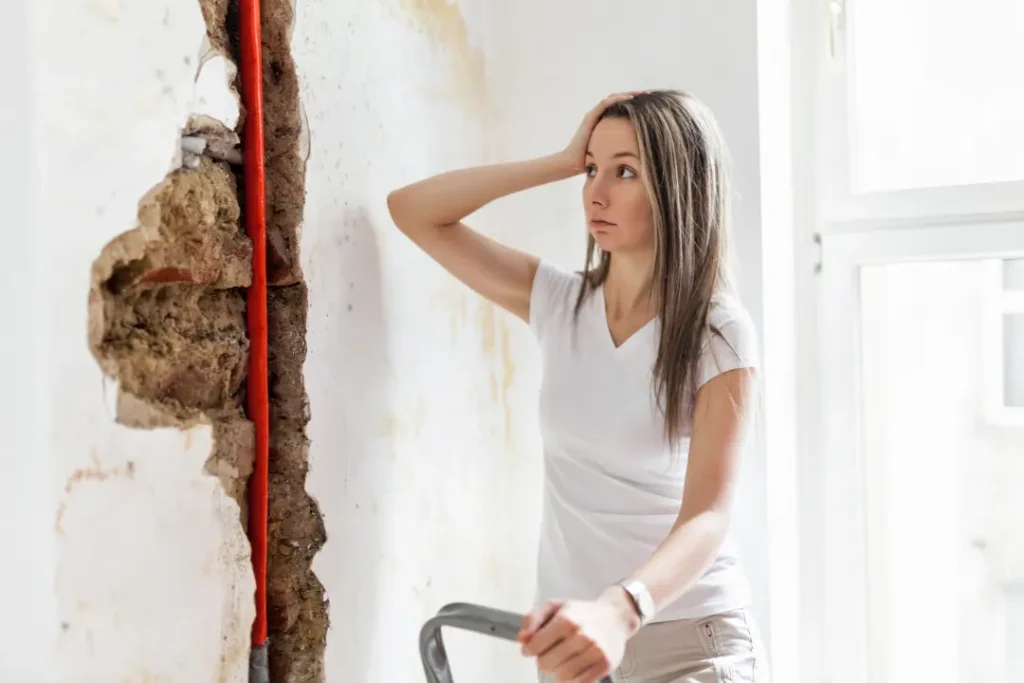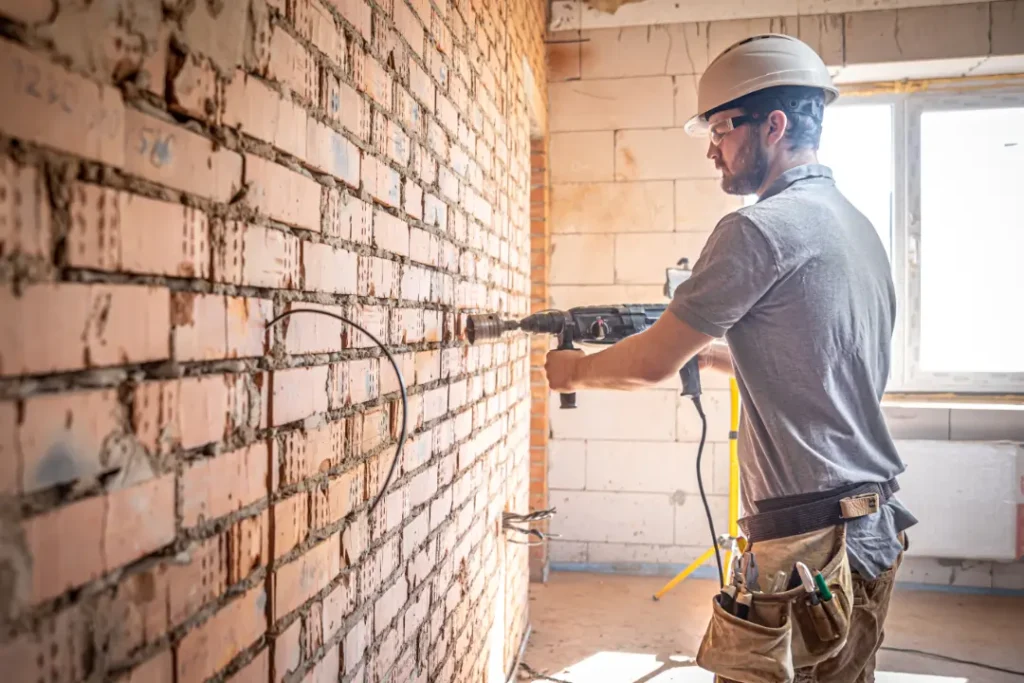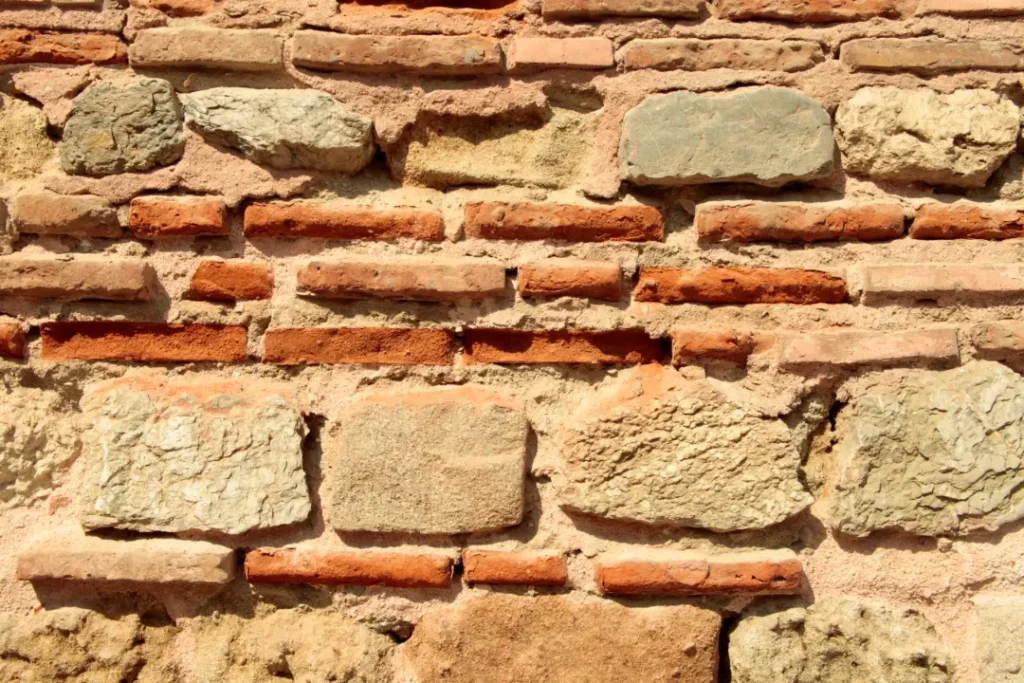If you’re asking, ‘will repointing stop damp,’ the answer is: it depends on the type of damp.
Repointing can effectively address penetrating damp caused by damaged mortar joints, but it may not be enough for rising damp or condensation issues.
This article delves into different types of damp, how repointing helps, and when additional measures are necessary, ensuring you tackle the issue correctly.
Key Takeaways
- Identifying the type of damp—penetrating, rising, or condensation—is crucial for selecting appropriate damp proofing methods.
- Repointing can effectively address penetrating dampness by sealing gaps in mortar joints, but additional measures like a damp proof course are often needed to raise dampness and improve ventilation for condensation.
- Comprehensive damp proofing strategies should include multiple methods, such as enhancing ventilation, fixing structural issues, and applying water repellent treatments to protect properties from moisture ingress.
What Causes Damp Problems in Homes? Understanding the Main Types
Various forms of damp can affect your property, and each requires a specific remedy to tackle the issue effectively. It’s crucial to determine which kind of damp is present in order to select suitable methods for damp proofing.
The main categories include penetrating damp, rising damp, and condensation—each distinct in its origins and indicators. If left untreated, these issues can cause significant damage.
Understanding these types helps pinpoint the root of moisture issues within your home or building.

Penetrating Damp
Penetrating damp arises when water infiltrates a building’s walls from the exterior, manifesting in moisture seeping through to interior surfaces. This condition can stem from structural deficiencies that facilitate water penetration, such as compromised brickwork, existing cracks, or materials with high porosity. Externally triggered aspects like substantial rainfall, blocked gutters and complications with the roofing system intensify this issue, resulting in visible damp spots on inner wall areas.
Signs of penetrating dampness include the presence of moist patches on internal walls alongside potential mould proliferation, which could escalate into wet rot if not addressed promptly. Resolving underlying construction flaws that grant passage for moisture includes actions such as repointing eroded mortar joints and applying defensive measures upon external wall surfaces, which are fundamental strategies used during penetrating damp treatment processes.
Rain penetration can become severe during periods of heavy rain, especially when the exterior walls or outer wall suffer from brick damage or missing tiles. These vulnerabilities allow overflowing water to breach the structure, leading to internal damp patches and possible mould growth.
Rising Damp
Rising damp is a situation where moisture absorption from the ground ascends through a building’s walls by capillary action. As water moves up through microscopic spaces in bricks and mortar, it creates noticeable damp spots on walls and can eventually cause structural harm.
To impede this upward migration of moisture, buildings are equipped with a feature known as a damp proof course (DPC), which serves as an impassable barrier. When there is no DPC present or if it has failed—often an issue in older structures—the integrity of the building can be seriously compromised due to rising damp, as original DPCs may have degraded over time.
Condensation
When warm air laden with moisture encounters surfaces chilled by cold weather, condensation manifests as water droplets on windows, walls, and various other surfaces. This phenomenon is frequently due to elevated internal humidity levels that may stem from everyday activities such as cooking, showering, or indoor clothes drying, which seal the moisture inside.
Should this situation remain unchecked, it can give rise to damp patches and foster the development of mould, which is both harmful to health and detrimental to the structural integrity of building materials. Proper ventilation and effective measures to regulate indoor humidity levels are essential for preventing these issues.
What is Repointing?
Renewing the mortar joints between bricks through repointing is essential for preserving the structural integrity of masonry walls. Over time, environmental factors and weathering may erode mortar, creating openings that enable moisture ingress.
It’s important to use a permeable mortar during repointing to prevent damp accumulation within walls that facilitates moisture evaporation. When the existing mortar has sustained substantial damage, carrying out this process is key in addressing rising damp and penetrating damp issues.

How Damaged Pointing Contributes to Damp
Cracked or missing mortar joints due to weathering, frost damage, or lack of maintenance can result in significant damp issues within a property. These compromised points allow water to seep through and infiltrate the walls, causing structural damage and visible damp patches.
To effectively counteract penetrating damp, repointing is utilised to fill these gaps and reinforce the wall’s ability to resist water ingress. Nevertheless, for lasting results, it is also crucial to remedy any contributing factors, such as roof damage or gutters that are not functioning properly.
Will Repointing Stop Damp?
Repointing is notably efficient in addressing certain damp issues, especially those caused by penetrating damp. Restoring the mortar joints helps to close off crevices through which moisture can enter, thus averting the formation of damp patches and subsequent water damage. However, repointing alone might not tackle all types of damp problems.
For example, treating rising damp typically involves more extensive measures such as fitting a new damp proof course. In cases where condensation is the problem, enhancing ventilation and managing indoor humidity levels may also be necessary alongside repointing efforts.
Understanding when repointing is sufficient and recognising when additional steps are necessary is crucial for an effective strategy against moisture penetration and related issues.
When Repointing Can Effectively Fix Damp Problems
Repointing is highly efficient for combating penetrating damp. Repointing inhibits water ingress into walls by sealing cracks and voids within the mortar joints.
This technique becomes particularly vital when the current mortar shows signs of decay, since it reinforces the wall’s capacity to resist moisture and uphold its structural integrity.
When Repointing Isn’t Enough for Damp-Proofing
Repointing alone might not rectify every issue related to damp. If the damp originates from ground moisture, fitting a damp proof course (DPC) can create an effective barrier against it.
Addressing condensation issues typically necessitates enhanced ventilation and managing humidity levels in conjunction with repointing efforts at this stage.
To tackle damp proofing effectively, a multifaceted strategy is often employed that targets different origins of moisture ingress. This approach could include repairing any damage to the roof, restoring bricks that have spalled due to exposure to elements, and confirming adequate drainage surrounding the property’s roof area.
Additional Measures for Comprehensive Damp Proofing
To tackle damp effectively, a mix of strategies is often necessary, going beyond simply repointing. Notably:
- Installing a damp proof course (DPC) is critical in thwarting the ascent of rising damp.
- Elevating airflow can be instrumental in regulating issues with condensation.
- Addressing structural faults can bolster the success rate of measures taken to combat dampness.
- The application of treatments that reject water can refine your property’s resistance against moisture.
Through these initiatives, you’re equipped to thoroughly resolve problems associated with dampness within your estate.
Installing cavity wall insulation can further shield your home’s interior from temperature fluctuations and moisture seepage through external walls. If your home begins to feel damp despite these measures, it may indicate underlying structural damage or inadequate moisture control.
Adopting this multifaceted stance towards combating moisture intrusion and related complications ensures an all-encompassing solution for safeguarding your real estate from various forms and effects of wetness penetration.
Damp Proof Course (DPC): What It Is and Why You Might Need One
A damp proof course is a critical installation for preventing moisture from rising into walls due to capillary action, a phenomenon known as rising damp. This process involves creating a robust, impenetrable barrier within the wall structure. For optimal effectiveness, the DPC should be placed no less than 150 mm above ground level, which helps to effectively halt moisture migration from the ground into the building.
It is an essential outlay, particularly in older properties where original methods of damp proofing may have lost their effectiveness over time. Ensuring that a DPC is properly installed is vital for effectively protecting against damp issues.
Improving Ventilation
Enhancing air circulation is essential in controlling condensation that, if neglected, may result in damp patches and the development of black mould. By promoting effective ventilation, indoor humidity levels are lowered, thwarting moisture buildup on cooler surfaces and improving the ease of breathing within your space.
It is especially crucial to ensure adequate airflow in areas prone to high moisture levels, such as kitchens and bathrooms. Improving the ventilation in these spaces can greatly diminish the likelihood of encountering damp-related problems due to condensation.
Water Repellent Treatments
Applying breathable water-repellent coatings to masonry walls helps thwart the infiltration of rain while simultaneously permitting moisture to evaporate. This strategy ensures protection for the structure, maintaining a dry state within the solid wall and diminishing potential water damage, particularly concerning both exterior and cavity walls.
Selecting suitable materials for these applications is critical to their success and to preserving the structural integrity of the masonry. Utilising unsuitable substances like hard lime mortar or cement mortar may trap moisture, thereby expediting deterioration.
Comprehensive Damp Solutions by Environ Property Services
At Environ Property Services, we identify and eliminate the root causes of damp to protect your home in the long term. As a leading damp proofing and property care company in London, we specialise in diagnosing and resolving all forms of damp, penetrating damp, rising damp, and condensation, with intelligent, effective, and lasting solutions.
Whether your property needs expert repointing to stop water ingress, a damp proof course (DPC) to combat rising moisture, or ventilation upgrades to control condensation, we deliver precision workmanship with zero guesswork.
Our team combines building science with hands-on expertise to safeguard your home’s structure, health, and value.
Our comprehensive services include:
- Specialist Repointing
- Rising Damp Treatments & DPC Installation
- Condensation & Mould Control
- Basement & Structural Waterproofing
- Heritage Property Damp Repairs
- Detailed Damp Surveys
- And More..
Book a professional damp survey with Environ Property Services today.
Get Repointing Services That Do More Than Just Fill Gaps
Repointing is often your property’s first line of defence—but only if it’s done right. At Environ Property Services, we don’t simply apply fresh mortar. We remove all compromised joints, use breathable lime-based mortars, and restore the wall’s integrity to resist rain and moisture.
This is especially crucial for treating penetrating damp caused by damaged brickwork or eroded pointing.
But effective damp proofing means looking beyond the bricks. Our team also inspects your home to ensure no weak point is left behind. When we repoint, we protect, not just repair.
Every solution is designed to work together, ensuring your home stays dry, mould-free, and structurally sound for decades to come. Contact us today.
Signs That Your Property Needs Repointing
Visible deterioration in the mortar joints, such as cracks and gaps, alongside damp patches on interior walls and decaying mortar, are key indicators that your property requires repointing. These signs suggest that the integrity of the mortar has been compromised, permitting moisture to seep through into the walls.
Addressing these problems promptly is essential for preserving your property’s structural stability. By undertaking repointing work, you can rectify these defects and reinstate the wall’s ability to resist penetration by moisture.

Frequently Asked Questions
Can repointing alone stop all types of damp?
Repointing alone cannot stop all types of dampness; it is primarily effective for penetrating dampness but does not address rising dampness or condensation, which may require a damp proof course or enhanced ventilation.
What are the signs that my property needs repointing?
If you notice visible cracks and gaps in the mortar joints, crumbling mortar, or damp patches on the internal walls of your property, these are indications that deterioration has occurred, allowing moisture to seep through.
It is crucial to deal promptly with problems as they arise to preserve the structural integrity of your property.
How much does it cost to install a damp-proof course?
The cost to install a damp proof course typically depends on the property’s size and condition.
Why is ventilation important in preventing damp?
To avoid damp issues, it is essential to maintain proper ventilation as it reduces the levels of indoor humidity. This reduction helps prevent condensation and mould formation, which are common precursors to damp problems.
What additional measures can enhance damp proofing?
To enhance damp proofing, consider installing a damp proof course, improving ventilation, and applying breathable water repellent treatments to masonry walls.
These measures collectively help prevent moisture accumulation and ensure long-term protection against dampness.
Conclusion
To summarise the critical considerations, it is essential to identify the specific type of damp affecting a building to determine an effective remedy. While repointing may be beneficial for addressing penetrating damp, this method alone might not suffice when dealing with rising damp or condensation-related issues. A combination of strategies, which could include adding a damp-proof course, enhancing ventilation, and applying water-resistant treatments, is vital for comprehensive damp proofing.
Ultimately, ensuring your property’s protection against moisture requires adopting an integrated approach. Focusing on root causes and employing various moisture control methods can help shield your structure from potential damage while preserving its structural integrity.
Choose Environ Property Services for expert, personalised solutions utilising cutting-edge technologies designed specifically for managing and rectifying damp issues and reporting.

